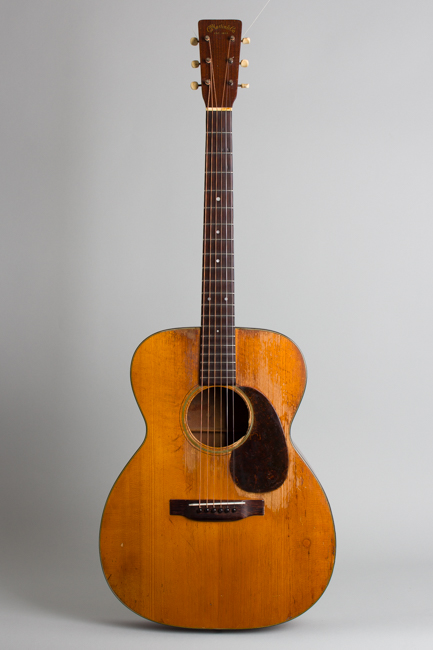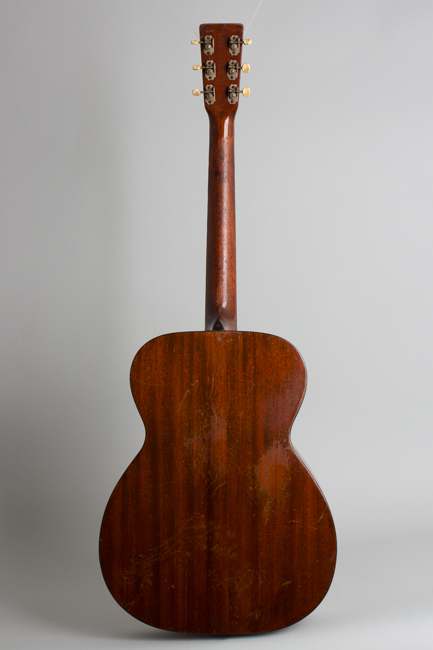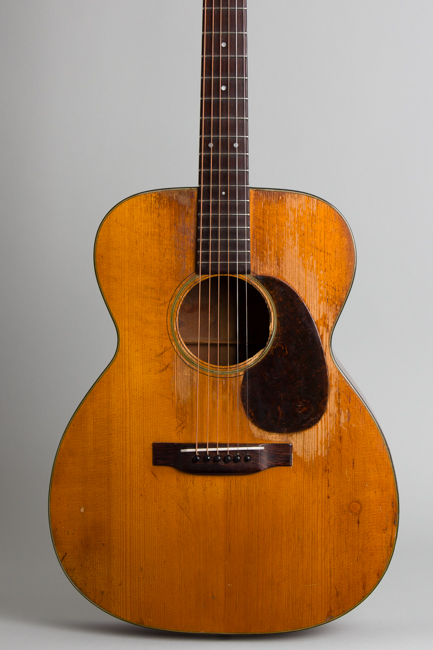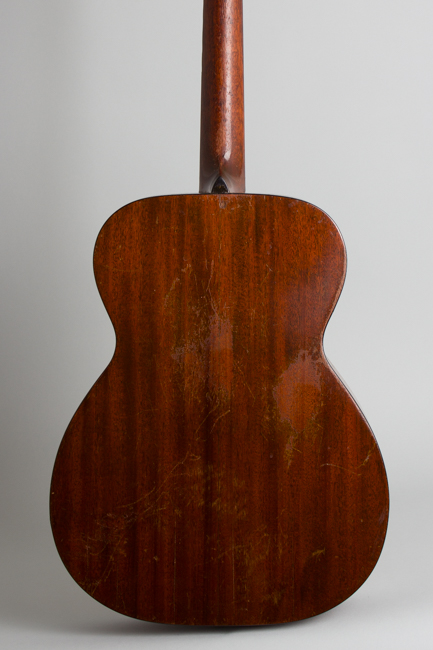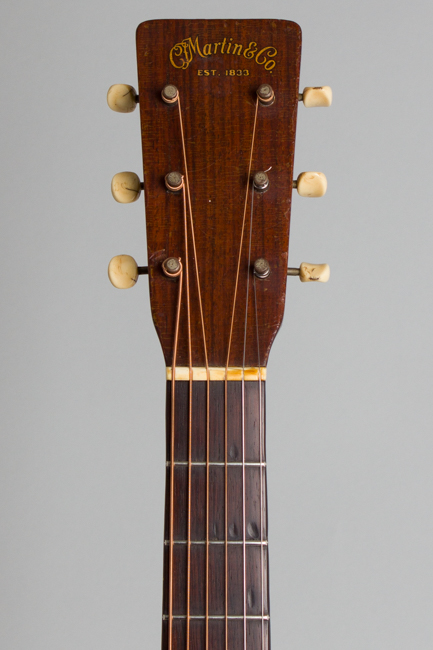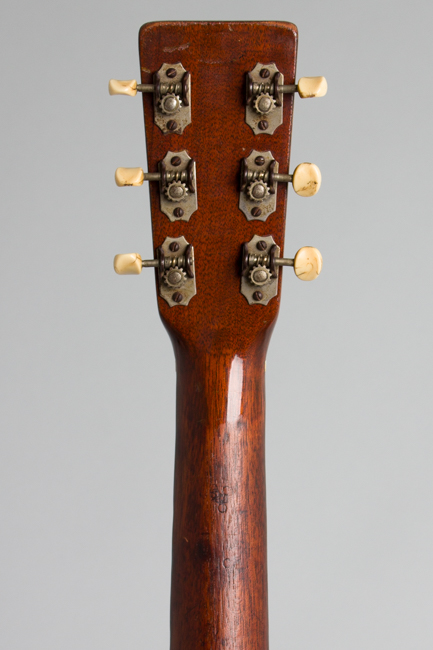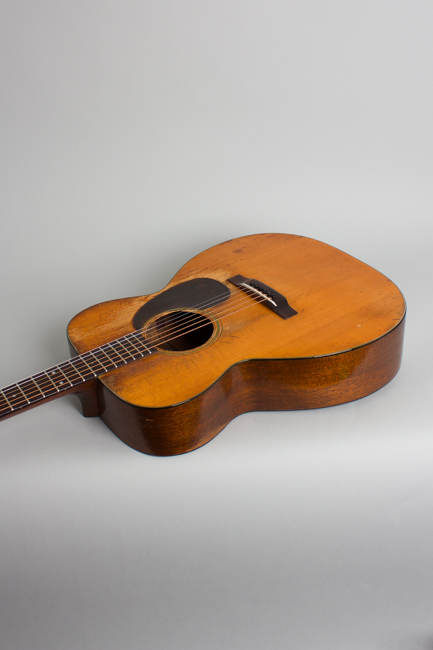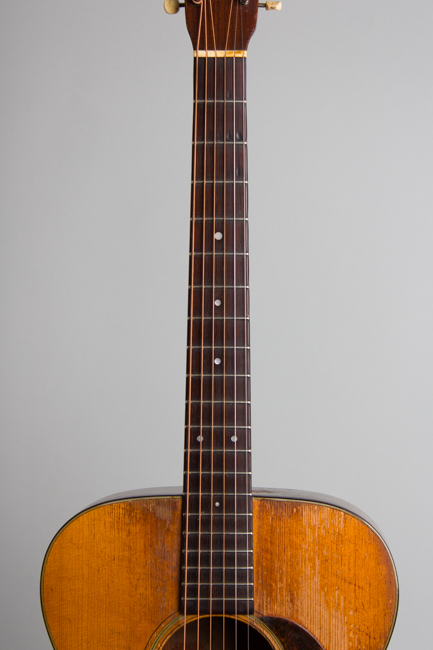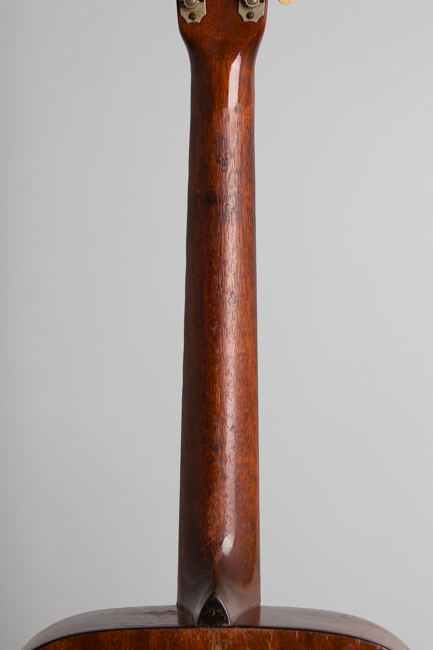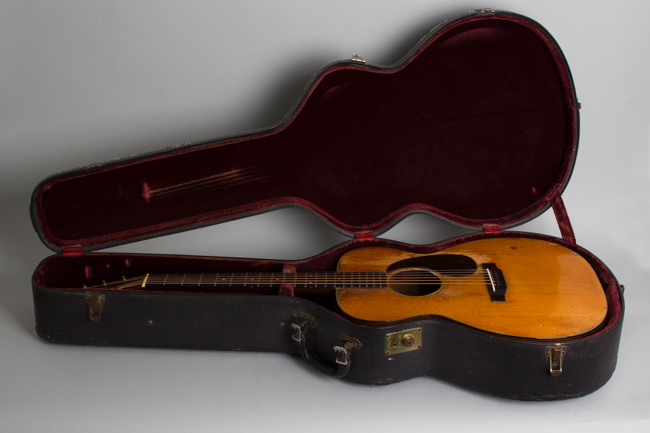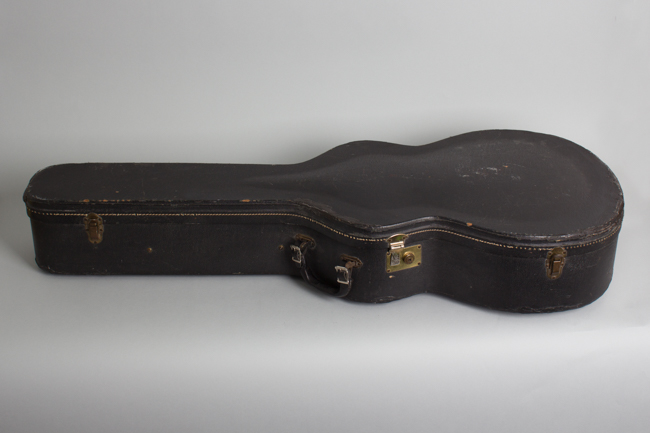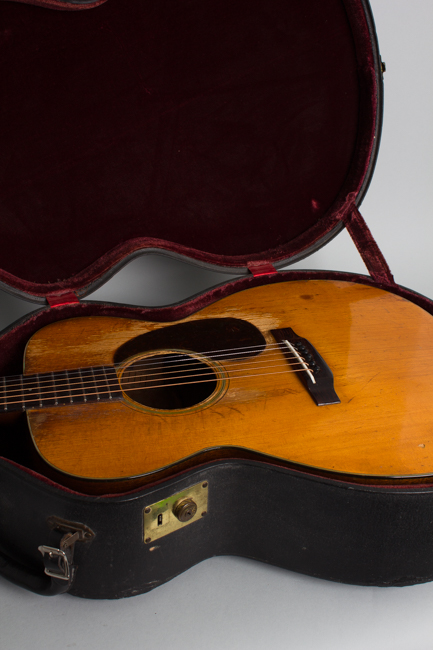C. F. Martin 000-18 Flat Top Acoustic Guitar (1944)
Just Arrived!
This item has been sold.
Item # 11612
Prices subject to change without notice.
C. F. Martin 000-18 Model Flat Top Acoustic Guitar (1944), made in Nazareth, PA, serial # 89611, natural lacquer finish, mahogany back, sides and neck, Adirondack spruce top; Brazilian rosewood fingerboard, period black hard shell case.
There are "relics", and there are RELICS; we like to call Martins like this "Ragged but Right" in honor of Riley Puckett and the Skillet Lickers. This massively worn-in wartime 000-18 is one of the coolest Martin survivors we have seen in a while, played for generations with gawd knows what sort of adventures behind it, but like those old Timex watches it took a likkin' and kept on tikkin'. Despite -- or perhaps thanks to -- an epic amount of wear and use this is a fabulous guitar to play and to hear, with a lot of stories to tell.
The 14-fret 000-sized body was introduced with the OM-18 in 1930; after 1933 nearly all Martin guitars were being built in this new "Orchestra Model" format so the OM designation was dropped, and this model simply designated the 000-18. The original OM-18 used a long 25.5" scale length, but Martin changed this to a slightly shorter scale in 1934. The 000-18 has remained one of the company's mainstays ever since.
This example was built fairly late in 1944 with features specific to this period, when much was in transition. It slipped in under the wire as a scallop-braced instrument, just before Martin eliminated that feature across the line. This Adirondack spruce top over a light mahogany body makes for a superbly responsive guitar; the 15" wide narrow-waisted 000 shape contributes both depth and clarity to the sound. The top has a tortoise celluloid pickguard and outside edge of the 5-ply binding, with a single layer for the back binding.
The mahogany neck is fairly slim with a subtle very rounded "V" profile typical of wartime Martins. The dark rosewood fingerboard is unbound with mixed size pearl dot inlay. There is no metal rod in the neck but an ebony reinforcement has helped it stay straight and true, making this guitar among the lightest 000s out there. The original tuners are wartime Klusons designed to use the minimum of metal, which was severely rationed at the time.
The 000-18 is not a flashy guitar; the trim is discreet but in classic Martin style elegant understatement speaks for itself. This is one of exactly 375 000-18s shipped in 1944 at the oddly specific wartime list price of $67 (sans case). During the war professional grade guitars were in short supply, and Martin had their hands full building them; even that number shipped likely represents a self-rationed total. Still unlike most other instrument builders Martin managed to keep up steady guitar production during the war and the instruments of that era have their own character. Despite its lack of glitz this was a fully professional instrument popular with radio entertainers, and this one appears to have served the owner(s) well over the last 80 years.
Overall length is 39 3/4 in. (101 cm.), 15 3/16 in. (38.6 cm.) wide at lower bout, and 4 1/8 in. (10.5 cm.) in depth at side, taken at the end block. Scale length is 24 3/4 in. (629 mm.). Width of nut is 1 11/16 in. (43 mm.)., 3.07 lbs.
While it really shows its 80 years this venerable Martin remains a superb player's instrument. It has seen an epic amount of use, a tremendous amount of wear and many mostly smaller repairs over the years. The guitar has obviously been heavily played with a significant amount of strum wear all over the top. The original pickguard is intact, with fairly deep wear into the wood surrounding it. Along the inner rim of the pickguard there is an area of spruce missing around the soundhole that has worn through the first single layer of binding in the rosette. The top shows a plugged hole along the lower bout on the treble side, likely from an old volume knob installation, and a couple of small grain splits at the edge of the lower treble bout. The top is otherwise amazingly crack free.
The majority of the finish is worn off the back of the neck, which has some feelable dings and capo dents mostly in the lower positions. The back of the body has large areas of belt buckle wear worn through the finish as well as numerous deep scratches, dings and nicks. There are five mahogany grain splits running parallel along the lower back off the rim of the lower bout, all of which have been cleated. Directly below the back of the heel there is a plugged strap button hole.
The sides have a fair amount of contact wear, scratches and nicks along the bass and treble sides, as well as a few old crack repairs. There are two long cracks running along the lower bout on the treble side, and the upper bout on the bass side reinforced with bias tape. Along the bottom side there are two sealed cracks, one of which was from an impact puncture through the side. The hole was filled in, and shows no sign of separation. The endpin hole had been plugged from an old jack installation.
Internally, the guitar has remained largely original with a few repairs that have not damaged its integrity. The original scalloped main braces are well intact with no signs of being altered or reglued. The original small maple bridgeplate has had the bridge pin holes previously plugged and redrilled to prevent further deterioration; there was also a small strip of maple added directly below it to prevent top distortion.
The neck has recently been cleanly reset, with a small shim neatly added under the fingerboard extension. The fingerboard has been neatly planed and refretted with appropriate wire, with only a few small divots still visible on the first three frets. The original rosewood bridge is intact; it has been slightly lowered on the treble side and has a new bone saddle installed. The original wartime tuners have been well preserved, and are fully functional. The 000-18 is housed in an old but slightly later period hardshell case. This guitar has certainly developed a very large sound over many years of play; it is certainly not for the "clean freak" but as real "genuine relic" acoustics go, they don't get much better than this. Overall Very Good Condition.
There are "relics", and there are RELICS; we like to call Martins like this "Ragged but Right" in honor of Riley Puckett and the Skillet Lickers. This massively worn-in wartime 000-18 is one of the coolest Martin survivors we have seen in a while, played for generations with gawd knows what sort of adventures behind it, but like those old Timex watches it took a likkin' and kept on tikkin'. Despite -- or perhaps thanks to -- an epic amount of wear and use this is a fabulous guitar to play and to hear, with a lot of stories to tell.
The 14-fret 000-sized body was introduced with the OM-18 in 1930; after 1933 nearly all Martin guitars were being built in this new "Orchestra Model" format so the OM designation was dropped, and this model simply designated the 000-18. The original OM-18 used a long 25.5" scale length, but Martin changed this to a slightly shorter scale in 1934. The 000-18 has remained one of the company's mainstays ever since.
This example was built fairly late in 1944 with features specific to this period, when much was in transition. It slipped in under the wire as a scallop-braced instrument, just before Martin eliminated that feature across the line. This Adirondack spruce top over a light mahogany body makes for a superbly responsive guitar; the 15" wide narrow-waisted 000 shape contributes both depth and clarity to the sound. The top has a tortoise celluloid pickguard and outside edge of the 5-ply binding, with a single layer for the back binding.
The mahogany neck is fairly slim with a subtle very rounded "V" profile typical of wartime Martins. The dark rosewood fingerboard is unbound with mixed size pearl dot inlay. There is no metal rod in the neck but an ebony reinforcement has helped it stay straight and true, making this guitar among the lightest 000s out there. The original tuners are wartime Klusons designed to use the minimum of metal, which was severely rationed at the time.
The 000-18 is not a flashy guitar; the trim is discreet but in classic Martin style elegant understatement speaks for itself. This is one of exactly 375 000-18s shipped in 1944 at the oddly specific wartime list price of $67 (sans case). During the war professional grade guitars were in short supply, and Martin had their hands full building them; even that number shipped likely represents a self-rationed total. Still unlike most other instrument builders Martin managed to keep up steady guitar production during the war and the instruments of that era have their own character. Despite its lack of glitz this was a fully professional instrument popular with radio entertainers, and this one appears to have served the owner(s) well over the last 80 years.
Overall length is 39 3/4 in. (101 cm.), 15 3/16 in. (38.6 cm.) wide at lower bout, and 4 1/8 in. (10.5 cm.) in depth at side, taken at the end block. Scale length is 24 3/4 in. (629 mm.). Width of nut is 1 11/16 in. (43 mm.)., 3.07 lbs.
While it really shows its 80 years this venerable Martin remains a superb player's instrument. It has seen an epic amount of use, a tremendous amount of wear and many mostly smaller repairs over the years. The guitar has obviously been heavily played with a significant amount of strum wear all over the top. The original pickguard is intact, with fairly deep wear into the wood surrounding it. Along the inner rim of the pickguard there is an area of spruce missing around the soundhole that has worn through the first single layer of binding in the rosette. The top shows a plugged hole along the lower bout on the treble side, likely from an old volume knob installation, and a couple of small grain splits at the edge of the lower treble bout. The top is otherwise amazingly crack free.
The majority of the finish is worn off the back of the neck, which has some feelable dings and capo dents mostly in the lower positions. The back of the body has large areas of belt buckle wear worn through the finish as well as numerous deep scratches, dings and nicks. There are five mahogany grain splits running parallel along the lower back off the rim of the lower bout, all of which have been cleated. Directly below the back of the heel there is a plugged strap button hole.
The sides have a fair amount of contact wear, scratches and nicks along the bass and treble sides, as well as a few old crack repairs. There are two long cracks running along the lower bout on the treble side, and the upper bout on the bass side reinforced with bias tape. Along the bottom side there are two sealed cracks, one of which was from an impact puncture through the side. The hole was filled in, and shows no sign of separation. The endpin hole had been plugged from an old jack installation.
Internally, the guitar has remained largely original with a few repairs that have not damaged its integrity. The original scalloped main braces are well intact with no signs of being altered or reglued. The original small maple bridgeplate has had the bridge pin holes previously plugged and redrilled to prevent further deterioration; there was also a small strip of maple added directly below it to prevent top distortion.
The neck has recently been cleanly reset, with a small shim neatly added under the fingerboard extension. The fingerboard has been neatly planed and refretted with appropriate wire, with only a few small divots still visible on the first three frets. The original rosewood bridge is intact; it has been slightly lowered on the treble side and has a new bone saddle installed. The original wartime tuners have been well preserved, and are fully functional. The 000-18 is housed in an old but slightly later period hardshell case. This guitar has certainly developed a very large sound over many years of play; it is certainly not for the "clean freak" but as real "genuine relic" acoustics go, they don't get much better than this. Overall Very Good Condition.
